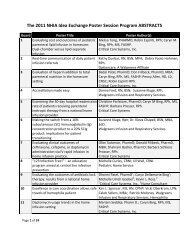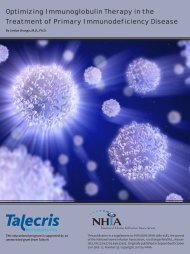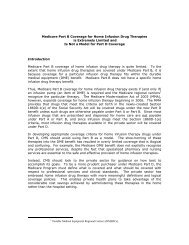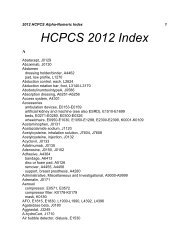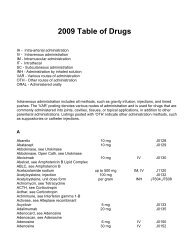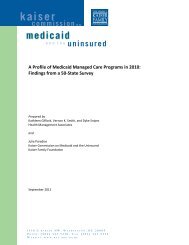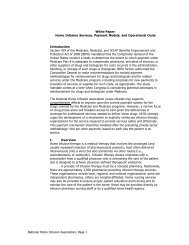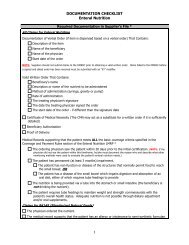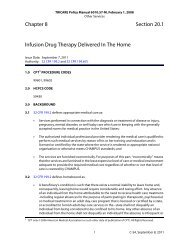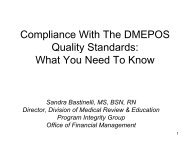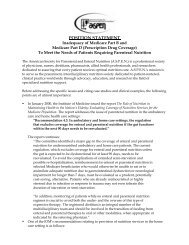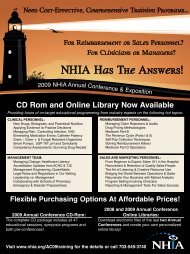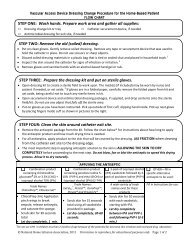Navigating Home Care: Parenteral Nutrition—Part Two
Navigating Home Care: Parenteral Nutrition—Part Two
Navigating Home Care: Parenteral Nutrition—Part Two
Create successful ePaper yourself
Turn your PDF publications into a flip-book with our unique Google optimized e-Paper software.
<strong>Navigating</strong> <strong>Home</strong> <strong>Care</strong>: <strong>Parenteral</strong> <strong>Nutrition—Part</strong> <strong>Two</strong><br />
NUTRITION ISSUES IN GASTROENTEROLOGY, SERIES #11<br />
Table 1<br />
HPN Checklist: Is Patient A Suitable Candidate<br />
• Risks and benefits of therapy have been discussed with<br />
patient.<br />
• All attempts to use GI tract have failed unless patient is<br />
clearly not appropriate for enteral feedings.<br />
• Modification of diet, use of feeding tube, special formulas,<br />
digestive enzymes, antiemetics, etc. have been<br />
attempted or considered.<br />
• Use of therapy is consistent with level of medical care.<br />
• Patient and/or caregiver assumes role of primary caregiver<br />
and is willing to administer therapy.<br />
• Patient and/or caregivers are capable to perform the<br />
task. Must demonstrate sound judgment and motivation<br />
to learn.<br />
• Patient and/or caregivers accept emotional requirements<br />
to administer therapy at home.<br />
• Patient and /or caregiver meet physical requirement to<br />
provide care (manual dexterity, adequate vision, physical<br />
strength to carry >10 lbs).<br />
• Patient is medically stable (requires labs no more than<br />
1–2× per week, glucose is controlled while on TPN).<br />
• <strong>Home</strong> environment is reasonably clean and has physical<br />
requirements needed to provide therapy (electricity,<br />
water, refrigeration, telephone).<br />
• Financial considerations/insurance coverage and patient<br />
responsibilities have been explored and patient and<br />
caregivers understand (and accept) cost.<br />
Used with permission Barnadas, G: Nutrition in <strong>Home</strong>care: PN<br />
module (4)<br />
HPN, coordinating their care with close follow-up and<br />
monitoring of clinical progress.<br />
Preparing the Patient for Discharge<br />
Is the patient appropriate for home therapy<br />
Identifying appropriate patients for home therapy is<br />
the first step toward successful HPN (3). Planning<br />
should begin early in order to identify potential obstacles,<br />
which may arise. The medical condition should<br />
be relatively stable. Vital signs, glucose, fluid and electrolytes<br />
are normal (or normal for the patient). Treatment<br />
and therapy options have been discussed and<br />
understood. See Table 1 for a suggested checklist to<br />
determine if patient is appropriate for HPN.<br />
Who will administer the therapy<br />
While care of the patient on HPN will be coordinated<br />
among an interdisciplinary health care team, the<br />
patients and/or their designated caregiver will ultimately<br />
be responsible for administering the therapy.<br />
Skilled IV nurses will be utilized initially to administer<br />
the therapy while the patient and/or their caregivers<br />
are taught. Typically it takes two-to three-days before<br />
the patient is expected to reach a point of self-sufficiency<br />
in the administration of the therapy. (Note: the<br />
role of the home care nurse is to educate the patient<br />
and caregivers until they are independent to<br />
administer the therapy. A common misconception<br />
is that the nurse will be there to administer the<br />
therapy and stay with the patient during the entire<br />
Table 2<br />
Nutrition Support Resources Available<br />
• Oley Foundation www.oley.org 800-776-OLEY<br />
– Has a large patient network that allows patients and<br />
caregivers to communicate with others in similar<br />
situations<br />
– Provides website information<br />
– A free newsletter for patients<br />
– A toll free network<br />
– Equipment exchange<br />
– Strong parents support group<br />
– Annual national conference for patients,<br />
families/caregivers<br />
• American Society of <strong>Parenteral</strong> and Enteral Nutrition<br />
(ASPEN) www.nutritioncare.org (800) 727- 4567<br />
– Standards of Practice for <strong>Home</strong> Nutrition Support<br />
(5)<br />
• Canadian <strong>Parenteral</strong>-Enteral Nutrition Association<br />
(CPENA) www.cpena.ca/home.html 613-825-4341<br />
(Ottawa)<br />
(continued on page 16)<br />
14<br />
PRACTICAL GASTROENTEROLOGY • NOVEMBER 2003



